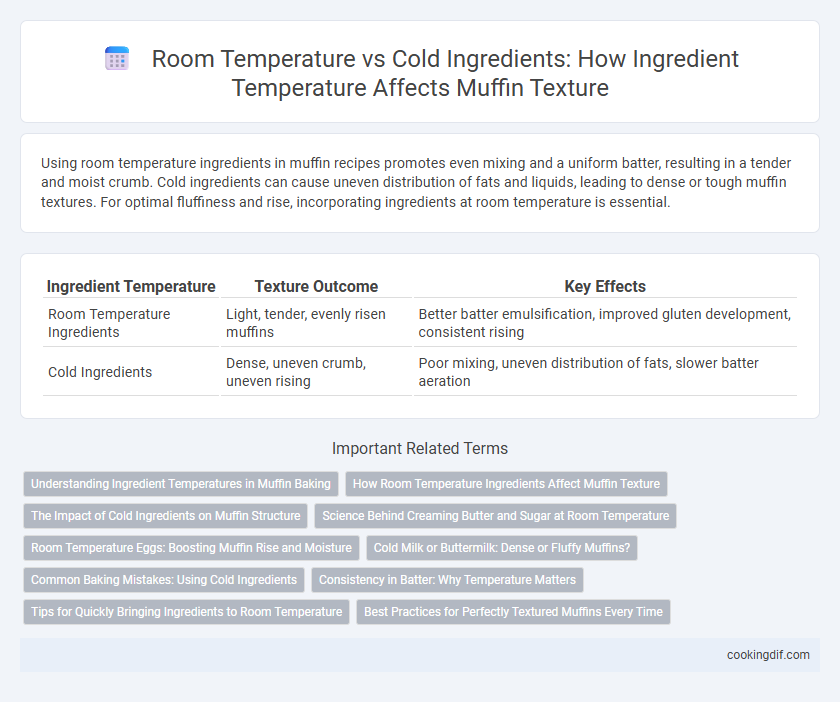Using room temperature ingredients in muffin recipes promotes even mixing and a uniform batter, resulting in a tender and moist crumb. Cold ingredients can cause uneven distribution of fats and liquids, leading to dense or tough muffin textures. For optimal fluffiness and rise, incorporating ingredients at room temperature is essential.
Table of Comparison
| Ingredient Temperature | Texture Outcome | Key Effects |
|---|---|---|
| Room Temperature Ingredients | Light, tender, evenly risen muffins | Better batter emulsification, improved gluten development, consistent rising |
| Cold Ingredients | Dense, uneven crumb, uneven rising | Poor mixing, uneven distribution of fats, slower batter aeration |
Understanding Ingredient Temperatures in Muffin Baking
Using room temperature ingredients in muffin baking promotes better emulsification, resulting in a tender and uniform crumb texture. Cold ingredients can hinder proper batter mixing and cause uneven rising, leading to dense or coarse muffins. Understanding the impact of ingredient temperatures optimizes muffin texture by ensuring consistent moisture distribution and crumb structure.
How Room Temperature Ingredients Affect Muffin Texture
Using room temperature ingredients in muffin recipes promotes better incorporation of air, resulting in a lighter, fluffier texture. Butter and eggs at room temperature blend more evenly with dry ingredients, ensuring a uniform batter that rises consistently during baking. Cold ingredients can cause uneven mixing and denser muffins due to reduced emulsification and slower chemical reactions.
The Impact of Cold Ingredients on Muffin Structure
Cold ingredients in muffin batter slow down the melting of butter and activation of leavening agents, resulting in a denser, tougher texture. The reduced temperature delays gluten development, which can cause muffins to have a less tender crumb and a more compact structure. Using cold ingredients often leads to muffins with a firmer bite and decreased rise compared to those made with room temperature components.
Science Behind Creaming Butter and Sugar at Room Temperature
Butter and sugar must be at room temperature to create a light and fluffy muffin texture because the creaming process traps air bubbles in the fat, which expand during baking and give muffins their rise. Cold ingredients cause the butter to remain solid, preventing proper aeration and resulting in dense, heavy muffins. The science behind creaming is that softened butter's pliability allows sugar crystals to cut into the fat, forming pockets of air essential for muffin volume and tenderness.
Room Temperature Eggs: Boosting Muffin Rise and Moisture
Room temperature eggs enhance muffin texture by promoting better aeration during mixing, resulting in increased rise and a lighter crumb structure. Cold eggs can cause the batter to curdle, leading to denser muffins with less moisture retention. Using eggs at room temperature ensures a smooth batter consistency, maximizing muffin volume and tenderness.
Cold Milk or Buttermilk: Dense or Fluffy Muffins?
Using cold milk or buttermilk in muffin batter results in denser muffins because the chilled liquid slows gluten development and yeast activity, producing a tighter crumb structure. In contrast, room temperature ingredients promote faster chemical reactions and better incorporation of air, leading to lighter, fluffier muffins with a tender texture. Choosing cold buttermilk specifically enhances moisture retention but reinforces density, ideal for hearty, cake-like muffins rather than airy, delicate ones.
Common Baking Mistakes: Using Cold Ingredients
Using cold ingredients in muffin recipes often leads to dense and uneven textures because the batter doesn't mix thoroughly, preventing proper gluten development and air incorporation. Room temperature ingredients, such as eggs and butter, blend more smoothly, resulting in lighter, fluffier muffins with a better crumb structure. Avoiding the common baking mistake of using cold ingredients ensures optimal rise and moistness in the final baked muffin.
Consistency in Batter: Why Temperature Matters
Room temperature ingredients create a smoother, more consistent muffin batter by allowing fats and sugars to blend evenly, promoting better aeration. Cold ingredients can cause uneven mixing, leading to clumps and a denser, less tender muffin texture. Maintaining consistent batter temperature ensures optimal gas retention during baking, resulting in a light and fluffy crumb.
Tips for Quickly Bringing Ingredients to Room Temperature
Bringing ingredients like eggs, butter, and milk to room temperature ensures a moist, tender muffin texture by promoting even mixing and proper leavening. To quickly warm eggs, place them in a bowl of warm water for 5-10 minutes, while butter can be softened by cutting it into small cubes or microwaving in short bursts at low power. Milk can be warmed by briefly dipping the container in warm water, all helping to speed up the process without compromising the batter's consistency.
Best Practices for Perfectly Textured Muffins Every Time
Using room temperature ingredients like eggs, butter, and milk ensures better integration and smoother batter, resulting in uniformly tender and moist muffins. Cold ingredients can cause uneven mixing and create dense, crumbly texture due to fat not blending properly with the dry components. Best practices include allowing ingredients to sit out for 30 minutes before mixing to achieve consistent rise and perfect crumb structure every time.
Room temperature ingredients vs Cold ingredients for muffin texture Infographic

 cookingdif.com
cookingdif.com